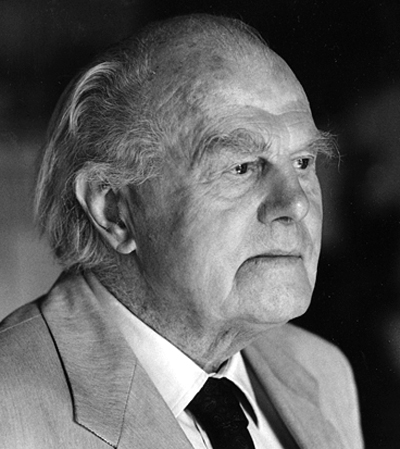- FR
S’inscrire
- Acheter
- Vendre
- Plus
- Galerie
- Commerce d'art
- Maison d'Édition
- Kornfeld aujourd’hui
- L'histoire de la Maison
- Informations

Eberhard Walter Kornfeld was born on 23 September 1923 in Nidda in Hesse, where his father Georg Waldemar Wilhelm Kornfeld worked as a designer in a furniture factory. His father later moved to Basel with the family to set up his own business as an interior designer and furniture dealer. From an early age, ‘Ebi’, as close friends called him, was interested in history and artistic artefacts, especially antiques and coins.
After completing a commercial apprenticeship, he had to do active service for the Swiss army during the Second World War. He was in talks with Herbert Adolf Cahn from the Basel coin dealer Münzhandlung Basel (later Münzen und Medaillen AG) about a possible job, but after initial, intensive contacts in 1944, he finally decided on a traineeship with the graphics dealer Dr August Klipstein in Bern. He started work in January 1945, and legend has it that he cycled to Bern. Kornfeld lived in a garret in the attic of the company.
His three-year traineeship came to an end in the spring of 1948. During the summer months, Kornfeld had the opportunity to work for several weeks in the print collections of museums. After the Kupferstichkabinett in Basel, he visited Paris, the British Museum in London and the Rijksprentenkabinet in Amsterdam, and later also the Albertina in Vienna, where he continued his self-taught training. Klipstein travelled around war-ravaged Europe with Kornfeld and became his mentor and patron.
Kornfeld was an extremely erudite employee and pupil, so Klipstein entrusted him with more and more projects. He eventually employed Kornfeld permanently and even took him on as a ‘mini-partner’ (as Kornfeld always said) in the company in 1948. Kornfeld was responsible for the auction of Maurice Delacre's collection of Dutch and Flemish drawings the following June.
When Klipstein collapsed at his desk one spring morning in 1951 and died shortly afterwards, long-time employee Frieda Schuh and the young Eberhard W. Kornfeld decided to continue the business together with his widow Frieda Klipstein. After a few years, Kornfeld became the sole managing director, gradually acquiring a majority stake and finally running the company under his own name from 1972. The Kornfeld auction house became an important and valued player in the international art trade, far beyond the graphic arts and Swiss borders. In the beginning, it was Kornfeld alone who wrote the auction catalogues, later supported by close colleagues and business partners such as Hans Bolliger and Christine E. Stauffer.
If one adds up his published auction, storage and exhibition catalogues as well as all the works not included in the auction, there were several 100,000 items that he examined at close quarters for their ‘import’. And since Kornfeld had a unique memory for images and materials, all nuances and deviations were immediately memorised. His impressive and well-founded knowledge quickly made him a widely respected ‘scholar-dealer’, a dealer who pursued his profession as a walking art encyclopaedia with an immense wealth of knowledge and experience and the highest level of expertise.
While auctions used to be mainly conspiratorial gatherings of dealers who went shopping for their customers or their own stock, the auction business changed radically after the Second World War. Private individuals now increasingly appeared as buyers, and auctions went from being purely an ‘insider's event’ at the so-called horseshoe table to a public ‘event’. In Switzerland, it was Kornfeld who recognised the signs of the times and from then on welcomed the ‘who's who’ of the art world to his auction room. From then on, art was no longer just described cryptically in the catalogues for ‘insiders’, now the aim was to promote it and make it accessible with colour illustrations - today we would say that the aim was to ‘communicate’ art. He was also the first person to dedicate separate catalogues to ‘Swiss art’, raising it to a new market level. Kornfeld quickly became a legend and his auctions became legendary. In 1972, he even made it onto the front page of the New York Times with his first million-dollar hammer price - for a painting by Paul Cezanne.
However, he was not only an auctioneer, but as a gallery owner and dealer also cultivated close, friendly and commercial contacts with artists of his time: Marc Chagall, Sam Francis, Alberto Giacometti, Joan Mitchell, Pablo Picasso, Niki de Saint-Phalle and Jean Tinguely are just a few examples of many others. He has also repeatedly dealt with cultural policy issues and was president of the Swiss Art Trade Association for 37 years.
Kornfeld also enjoyed sharing his extensive knowledge with others, which led to him publishing and compiling epochal catalogues raisonnés and setting new standards in the process. Today, experts, dealers and collectors around the world categorise and describe the status of prints by Paul Gauguin, Alberto Giacometti and Paul Klee, for example, using so-called ‘Kornfeld numbers’.
Until his 99th birthday, he came to his office in the ‘Villa Thurmau’ at Laupenstrasse 41 in Bern, where the company was based, almost every day. There were probably few art dealers who held nearly as many works in their hands as Ebi did during his long career as a dealer and collector.
After a rich and fulfilling life, he passed away peacefully at home on the morning of 13 April 2023, at the age of 100.